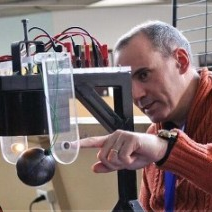Superconducting Materials for Applications
A special issue of Materials (ISSN 1996-1944). This special issue belongs to the section "Materials Physics".
Deadline for manuscript submissions: 23 November 2024 | Viewed by 21003
Special Issue Editors
Interests: magnetic materials; ceramics (ferrites and manganites); magnetic imaging; magnetic characterization
Special Issues, Collections and Topics in MDPI journals
Interests: electric characterization of superconducting tapes; magnetic characterization of superconducting bulks; AC losses in superconductor; power electronic
Interests: high-temperature superconducting (HTS) cables for railway network; magnetization and characterization of HTS bulks; pulsed magnetization; multiphysics modeling; design of electrical engineering applications using HTS
Special Issues, Collections and Topics in MDPI journals
Interests: superconducting fault current limiter; superconducting motor and generator; superconducting modulization and characterization
Interests: electrical, magnetic and thermal measurements; characterization of bulks and tapes; flux trapping; magnetic shielding; AC losses
Special Issues, Collections and Topics in MDPI journals
Special Issue Information
Dear Colleagues,
High-temperature superconductor (HTSc) materials have left the prototype-development stage and are now approaching different types of applications in the real world. Three basic types of superconductor materials are currently produced: thin films for electronic applications, coated conductors (tapes) mainly for power applications, and bulk materials for field trapping or screening. All of these material types are still not matured, as for each type, there are several different material classes to be considered, each with quite specific parameters (transition temperature Tc, critical current density, Jc, and irreversibility fields, Hirr). Therefore, for a given application, there are several possible solutions which clearly depend on the best fit of the material’s properties to the application demands. After this decision is made, the involved material costs and the costs of the required cooling apparatus are then decisive.
The development of superconducting applications is also driven by the current environmental challenges (e.g., for all-electric aircrafts) and by political demands to become independent of short resources like rare-earth materials (e.g., the development of superconducting supermagnets).
Therefore, there are many demands on the material development, the solution of which demands interdisciplinary developments and the use of the most modern material characterization tools to enable the applications of HTSc materials in daily life.
This Special Issue therefore aims to present several new applications of HTSc materials, the specific material processing required for a given application and new analysis methods applied in the HTSc research.
Prof. Dr. Michael R. Koblischka
Prof. Dr. Douine Bruno
Assoc. Prof. Dr. Kévin Berger
Prof. Dr. Leveque Jean
Prof. Dr. Philippe Vanderbemden
Guest Editors
Manuscript Submission Information
Manuscripts should be submitted online at www.mdpi.com by registering and logging in to this website. Once you are registered, click here to go to the submission form. Manuscripts can be submitted until the deadline. All submissions that pass pre-check are peer-reviewed. Accepted papers will be published continuously in the journal (as soon as accepted) and will be listed together on the special issue website. Research articles, review articles as well as short communications are invited. For planned papers, a title and short abstract (about 100 words) can be sent to the Editorial Office for announcement on this website.
Submitted manuscripts should not have been published previously, nor be under consideration for publication elsewhere (except conference proceedings papers). All manuscripts are thoroughly refereed through a single-blind peer-review process. A guide for authors and other relevant information for submission of manuscripts is available on the Instructions for Authors page. Materials is an international peer-reviewed open access semimonthly journal published by MDPI.
Please visit the Instructions for Authors page before submitting a manuscript. The Article Processing Charge (APC) for publication in this open access journal is 2600 CHF (Swiss Francs). Submitted papers should be well formatted and use good English. Authors may use MDPI's English editing service prior to publication or during author revisions.
Keywords
- high-temperature superconductor (HTSc) materials
- thin films for electronic applications
- coated conductors
- bulk materials for field trapping or screening
Benefits of Publishing in a Special Issue
- Ease of navigation: Grouping papers by topic helps scholars navigate broad scope journals more efficiently.
- Greater discoverability: Special Issues support the reach and impact of scientific research. Articles in Special Issues are more discoverable and cited more frequently.
- Expansion of research network: Special Issues facilitate connections among authors, fostering scientific collaborations.
- External promotion: Articles in Special Issues are often promoted through the journal's social media, increasing their visibility.
- e-Book format: Special Issues with more than 10 articles can be published as dedicated e-books, ensuring wide and rapid dissemination.
Further information on MDPI's Special Issue polices can be found here.








